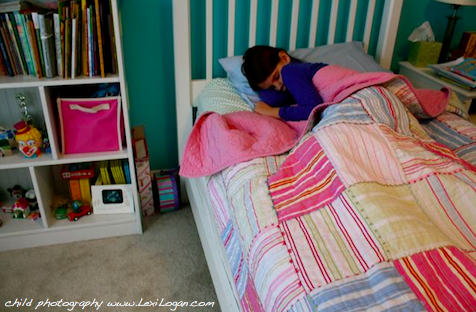 Our guest blogger, Dr. Kristann Heinz, a doctor who practices with a holistic and integrative approach, shares her knowledge about melatonin use in children. — Drs. Kardos and Lai
Our guest blogger, Dr. Kristann Heinz, a doctor who practices with a holistic and integrative approach, shares her knowledge about melatonin use in children. — Drs. Kardos and Lai
When we got back from Hawaii my three year old daughter, Ruby, was a hot mess! The eight-hour time difference made it hard for her to adjust her internal clock. At first, I just attributed it to routine jet lag but after a week of the same sleep-wake cycle, I knew something was going on. She was wandering around the house in her pink spotted pajamas WIDE AWAKE until 1am, 2am, and 3am. And then in the morning, she was dead asleep and I could barely get her up. So at this point, I took her to our doctor to make sure everything was all right. The doctor told us my daughter’s jet lag was leading to a sleep disturbance and suggested I try melatonin. I gave melatonin to Ruby that night. She was asleep by 11pm and slept soundly until morning. Over the next few days, she adjusted beautifully and we were back to a normal sleep routine in 3 days. After that, we stopped the melatonin.
What is Melatonin?
Melatonin is a hormone that occurs naturally in our bodies. A hormone is a signal containing a message from one part of the body to another. Melatonin is naturally secreted by the pineal gland, a gland located in the brain that is very sensitive to light. As night falls, the pineal gland secretes melatonin to tell the brain that it is time to sleep. This process is sometimes described as the “opening of the sleep gate.”
Why would my doctor prescribe melatonin to my child?
People often use melatonin to help adjust their sleep-wake cycles. For adults melatonin is used to treat a variety of medical disorders including cancer, headaches, and autoimmune disorders as well as insomnia. In children however, the primary reason melatonin is prescribed is for sleep disturbance. Some children with certain medical conditions are thought to have lower levels of naturally produced melatonin, which contributes to sleep-wake disturbances. For these children supplementing with melatonin can be beneficial and enhance sleep. Melatonin has been studied and shown to be helpful to children with developmental delays, ADHD, cerebral palsy, autism, and jet lag.
What dose should I use?
The dose of melatonin should be discussed with your doctor. Doses can range from 0.03mg – 6mg, generally given at bedtime. To establish the appropriate therapeutic dose, your doctor will take into account your child’s weight and the health condition you are trying to treat.
Are there different kinds of melatonin?
Melatonin is synthetically produced but there are also products that contain biological glandular material, a source of natural melatonin. Synthetically produced melatonin is recommended by most doctors because it provides a more consistent dose and is less likely to be contaminated.
Melatonin comes in three different forms: immediate release, sustained released and sublingual. The most convenient form of melatonin for children is the sublingual form because their bodies begin to absorb it as soon as it is placed in the mouth. The sublingual form is easier than swallowing a pill, which can be difficult or uncomfortable for some children. There are many different liquid brands available as well, which have the same benefit. Another good way to administer melatonin to a child is to dissolve an immediate release melatonin tablet in juice or mix it with applesauce before offering it to your child. Taking melatonin with food does not change the effectiveness of the supplement.
How long does it take to work?
Melatonin should work the first night it is given to a child and it does not require multiple doses to be effective. It can take up to 30 minutes after taking the medication to experience its full effect. Often your child will begin to feel drowsy and tired soon after taking the supplement.
Let’s use jet lag as an example of how to use melatonin. You may give the melatonin to your child just before bedtime in the new time zone. The supplement will facilitate sleep within 30 minutes of taking it. But, remember, our internal clocks usually adjust one hour a day when we travel to different time zones, and melatonin can only help to a point. The greater the time difference the more difficult it is for our bodies to resume a normal sleep pattern in the new time zone. If, for instance, there is a twelve-hour time difference, it will still take time for our biologic rhythms to change, even with the help of melatonin. However, the transition is often faster and smoother with the aid of melatonin. Melatonin is not a sleeping pill. It is used to enhance the onset of sleep naturally.
Are There Side Effects or Contraindications?
Melatonin is very safe. The most common side effect for children is excessive sleepiness, which can be moderated by decreasing the dose. In high doses, which are used mostly in treating adults (10mg-60mg melatonin), side effects include headaches, nausea, dizziness and fatigue. For children, taking melatonin is not associated with any short or long-term side effects in relation to growth, development or puberty. Drug interactions can take place between melatonin and sedatives, antidepressants and hormones, so if your child is taking medications of this kind, be sure to discuss whether it is safe to give your child Melatonin with your child’s doctor before doing so.
Kristann Heinz, MD, a graduate of University of Pennsylvania School of Medicine, is board-certified in Family Medicine and Integrative-Holistic Medicine, as well as certified in Medical Acupuncture. She is also a Registered Dietician and Licensed Nutritionist. A mom living in Bucks County, PA, she practices medicine at Stockton Family Practice in Stockton, NJ.
©2014 Two Peds in a Pod®



